Parks Plan Update

Bringing people to parks and parks to people.
ACKNOWLEDGMENTS
City Council
Mayor: Mary-Ann Baldwin
Mayor Pro Tem: Jonathan Melton
Mary Black
Corey Branch
Stormie D. Forte
Jane Harrison
Christina Jones
Megan Patton
Raleigh Parks Leadership Team
Stephen C. Bentley, Director
Silas Charles Craig III, Assistant Director
Adam Forman, Assistant Director
Giavonia Harris, Executive Management Coordinator
Kenneth Hisler, Assistant Director
Helene McCullough, Administrative Superintendent
Aundrea White, Equity and Strategic Initiatives Manager
Core Client Team
Shawsheen Baker, Capital Projects Superintendent
Emma Liles, Capital Project Manager
TJ McCourt, Planning Supervisor
Lauryn Kabrich, Park Planner
Jai Butts, Park Planner
Denise Saunders Warren, Recreation Program Director
Michael DaGrosa, Grounds Superintendent
Michael Gutenkunst, GIS Manager
Zach Jewell, Park Planning Specialist
Parks, Recreation and Greenway Advisory Board
Beverley S. Clark
Carol Ashcraft
Iain Burnett
Kate Dixon
Col. Robert Edgerton
Gregory Etheridge
Hugh Fuller
Jeff Havener
Douglas A. Johnston
Rashawn King
April Love
Shangwen Liu
Christopher Pereira
Kara A. Strang
Marsha Presnell-Jennette
Consultant Team
Agency Landscape + Planning
BerryDunn
McAdams
Toole Design Group
A special thank you to the many community members and City staff who contributed their time and ideas to the planning process and guided the Raleigh Parks Plan Update.
Chapter 3: Plan Process
Chapter

RALEIGH PARKS PLAN UPDATE PLAN SUMMARY
Why Does Raleigh Need a Parks Plan Update?

Raleigh is a city on the rise, and its parks, greenways, and cultural spaces must grow with it! This plan is a celebration of all that Raleigh Parks has achieved and a blueprint for an even brighter future. Over the past 10 years, Raleigh Parks has:
• Completed 91% of the 300+ action items established in the 2014 Parks System Plan.
• Expanded access to parks and places to play, especially in underserved areas.
• Grown the greenway network to protect natural resources and connect neighborhoods.
• Launched new programs for people of all ages and backgrounds.
Raleigh Parks has accomplished all of this even as the city continues to grow and welcome new residents. Raleigh is one of the fastest-growing cities in the country, and with that growth comes the need to ensure its parks continue to be vibrant, welcoming spaces for all. As the city continues to evolve, so must our approach to building and sustaining a world-class park system.

Planning Process
Over 16 months, starting in Spring 2023, the project team worked with the Raleigh community, staff, and partners to create a plan that reflects our shared vision for the future. The process had three key steps:
1. Listen and Learn: Gathered input from across the community.
2. Vision and Framework: Built a strong foundation for the goals.
3. Outcomes and Actions: Identified clear steps to achieve the vision.
This update isn’t just a refresh of the 2014 Parks System Plan—it affirms a commitment to equity, health, and inclusion in everything Raleigh Parks does!
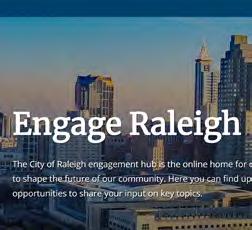

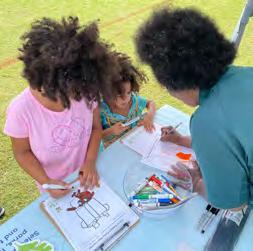
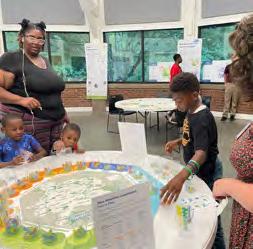
HOW DID ENGAGEMENT INFORM THIS PLAN?
During this process, there were three big ways that community and staff engagement shaped this plan:
#1 Community Values focused on Health!
People who participated in this plan process shared that they value “healthy lifestyles” most in their park system, which is why this plan is focused on improving health outcomes across Raleigh Parks.
#2 Raleigh Parks, the organization, needs to be healthy too!
Over half of the ideas for future projects, policies, and programs were to better support Raleigh Parks staff, who work to make everyone’s experiences so special.
#3 Places for nature need to be balanced with places for play!
In public workshops and in surveys, people said they wanted more ways to be in nature and to ‘walk or ride a bike’. ‘Places for open play’ was also identified as a top priority. There are many policies, projects, and projects that want to provide places for both to happen, while also ensuring people of all ages feel safe and welcomed in their parks.
The Raleigh Parks Plan: A Vision Through Four Heal
th
Lenses
VISION & PLAN STRUCTURE
The guiding vision of Raleigh Parks remains: “Bringing people to parks and parks to people.” This vision isn’t just about creating parks; it’s about creating connections—between people, nature, and the vibrant culture of Raleigh. The vision is supported by eight guiding principles.
HEALTH-FOCUSED FRAMEWORK
This plan is built around four key health lenses that reflect what the community values most in Raleigh’s parks. These lenses each represent a different perspective on the many ways that parks can improve the city, its communities, and everyone’s lives. Each lens includes several “outcomes”. These outcomes identify the desired result of the plan and its implementation.
PROJECTS, POLICIES, AND PROGRAMS
To guide implementation, each health lens has between nine and thirteen actions. These actions are organized into whether the action is a project (e.g., building a trail), policy (e.g., park facility reservation rules), or a program (e.g., expanding the number of in-park events).
Raleigh community and staff engagement
Nationwide best practices research
VISION
Bringing people to parks and parks to people.
EIGHT GUIDING PRINCIPLES
Connectivity and Access
Equity and Justice
Continuous Reinvestment
Collaboration and Coordination
Creativity and Innovation
Community and Belonging
Culture and History
Resilience and Stewardship
Check out how the vision and guiding principles relate to the health-focused framework and projects, policies and programs, above and on the next page.
HEALTH-FOCUSED FRAMEWORK
Four health lenses and fifteen health outcomes.
Individual Wellbeing
Physical Wellbeing
Access to play, exercise, and a healthy lifestyle
Mental Wellbeing
The ability to pursue emotional, psychological, and social wellbeing
Inclusion & Relevance
Reduced barriers and something for everybody
Belonging
A sense of community identity and belonging
Relationships
Strong relationships with communities
Development
Balanced growth and a robust local economy
Connectivity
Connections between people, places, and communities
Ecology
A sustainable, resilient, citywide ecological framework
Sites & Facilities
Best design, management, and operational practices in all sites and facilities
Stewardship
A community of active and passionate stewards
Protection
Sensitive habitats and corridors are protected
Support
Difference embraced and invested in, in all its forms
Cultivate
A workforce representative of the community
Innovate
A culture of innovation, creativity, and collaboration
Empower
A model parks and recreation agency committed to equity and effectiveness
Individual Wellbeing Park Experience
Raleigh-owned Parks
Other Open Space
Core Experience (10-min walk) Neighborhood Experience (5-min drive) Greenways
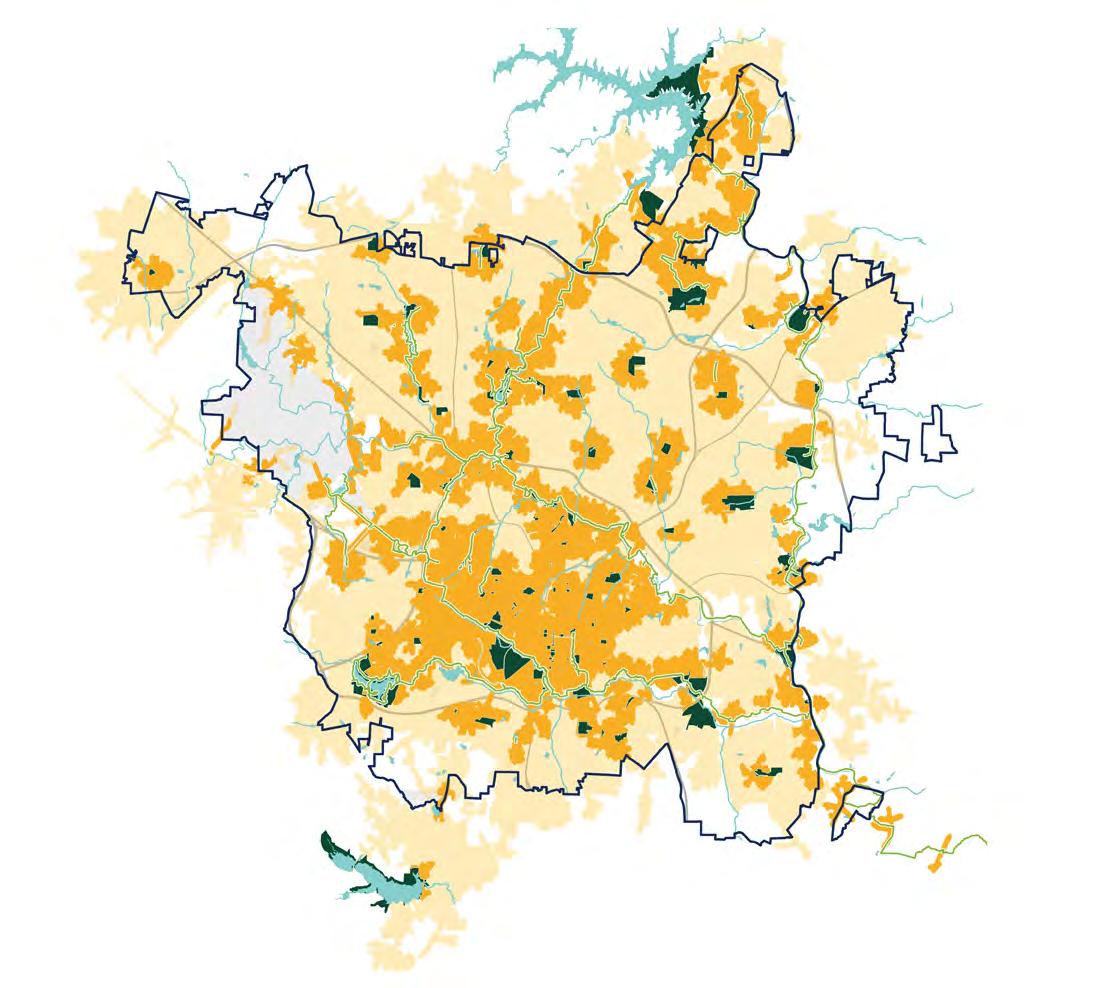
Individual Wellbeing
Parks are more than just physical spaces—they’re vital to our health and happiness! Access to the outdoors encourages physical activity, reduces chronic illness, and supports mental well-being. But it’s not enough just to have parks; we need to ensure everyone can enjoy them. That means breaking down barriers and welcoming everyone to the wide range of experiences Raleigh Parks offers.
The Individual Wellbeing lens includes three health outcomes: #1 #3 #2
PHYSICAL WELLBEING: Access to play, exercise, and a healthy lifestyle
MENTAL WELLBEING: The ability to pursue emotional, psychological, and social wellbeing
INCLUSION & RELEVANCE: Reduced barriers and something for everybody
Policies
Expand inclusive policies to support a full spectrum of users, including people who are neurodivergent, have visual impairments, physical disabilities, or language isolation.
Remove barriers for teen participation in programs and access to facilities.
Programs
Leverage partnerships and internal capacity to increase the number of free activities, programs, and events.
Strengthen Financial Assistance programs and funding to reduce barriers for households to participate in programs.
Identify mental health “hubs” - or distributed clusters of resources - throughout city, expanding the pilot mental health programming already provided at Dix Park.
Expand active adult program offerings and craft a marketing strategy to more effectively reach seniors who are unaware of program availability.
Expand drop-in and open play availability, especially for athletics or sports-related uses.
Create programs along greenway trails that better activate the greenway trails. Programs could include history, nature, or art-themed events that align with the Public Art Plan.
Projects
Inclusion & Relevance
Mental Wellbeing
Inclusion & Relevance
Inclusion & Relevance
Mental Wellbeing
Inclusion & Relevance
Physical Wellbeing
Physical Wellbeing
Expand shade citywide (trees/constructed shade) through the Street Tree Equity Project and through parks and facilities reinvestment projects. Mental Wellbeing
Expand offerings for wheeled resources for all ages. This could include all-ages recreation and education facilities like skate parks, Traffic Gardens, pump tracks, natural surface trails for mountain biking, and bike repair stations.
Strive for building amenities beyond ADA-accessibility and universal design.
Physical Wellbeing
Inclusion & Relevance
Community Cohesion Park Experience
Raleigh-owned Parks
Other Open Space
Core Experience (10-min walk)
Neighborhood Experience (5-min drive) Greenways

Community Cohesion
Raleigh’s parks are the heart of its neighborhoods, bringing people together and building strong communities. They reflect the unique character of each area while adapting to changes. Parks are where relationships are formed, cultures are celebrated, and communities grow stronger together.
The Community Cohesion lens includes four health outcomes: #1 #3 #2
BELONGING: A sense of community identity and belonging
RELATIONSHIPS: Strong relationships with communities
DEVELOPMENT: Balanced growth and a robust local economy
CONNECTIVITY: Connections between people, places, and communities #4
Action
Integrate arts and culture in projects and programs.
Revisit policies for volunteer work to strengthen and expand volunteerism and community park stewardship.
Partner across departments to identify and establish policies that incentivize the creation of publicly accessible parks and greenways as part of the land development process.
Programs
Partner to provide assistance to unhoused community members and persons experiencing mental health crises.
Translate Raleigh Planning Academy to a park-specific program that encourages community and department dialogue.
Expand community gardens, especially in neighborhoods with mixed use or high-density zoning or a food desert.
Expand the Welcome to Raleigh Parks program, providing a landing resource for newcomers to the city.
Provide revenue-generating services along greenways like food trucks and events that engage small and minority businesses.
Projects
Expand the Neighborhood & Community Connections Program through capital improvement as well as publicprivate partnerships.
Pilot marketing and communications programs with various workgroups to increase and inform relationships with the Raleigh community, especially those who do not participate in programs today.
Enhance design and programming to activate the greenway and ensure it is welcoming to all visitors.
Implement the next phases of the Dix Park Master Plan, and prioritize build-out of parks with multi-phase master plans.
Collaborate with other city departments and promote and incorporate greenway trails to support multimodal, active transportation.
Belonging
Relationships
Development
Relationships
Relationships
Belonging
Belonging
Development
Connectivity
Relationships
Connectivity
Development
Connectivity
Environmental Resilience Park Experience
Raleigh-owned Parks
Other Open Space
Core Experience (10-min walk)
Neighborhood Experience (5-min drive) Greenways
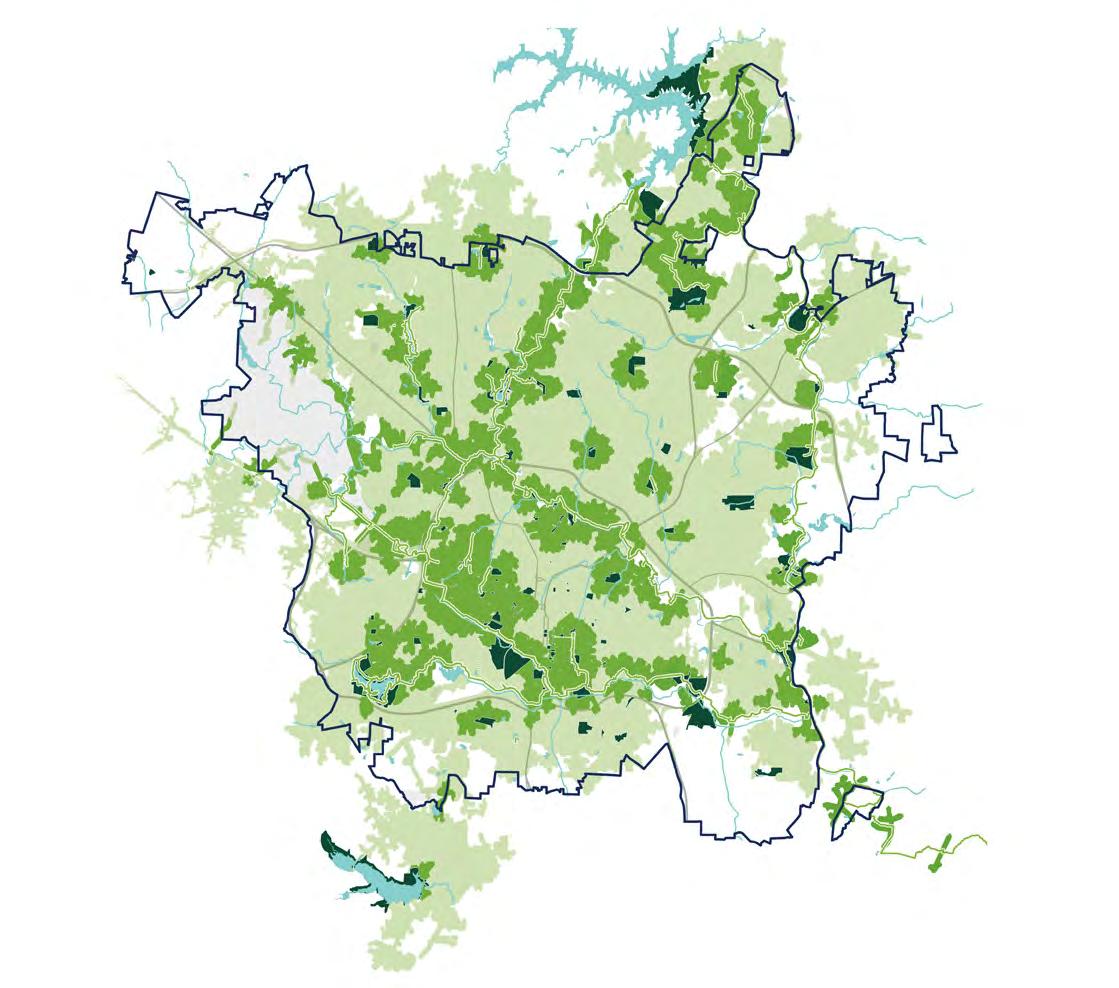
Environmental Resilience
Raleigh is a leader in environmental stewardship, and the park system is the backbone of the local ecosystem. The lands and waters Raleigh Parks manages are crucial in limiting flood risk, reducing temperatures, cleaning the air, and protecting wildlife. Parks and greenways are vital to the city’s resilience in the face of climate change and the biodiversity crisis, and Raleigh Parks is committed to preserving these natural spaces for future generations.
The Environmental Resilience lens includes four health outcomes:
#1
#3 #2
#4
ECOLOGY: A sustainable, resilient, citywide ecological framework
SITES & FACILITIES: Best design, management, and operational practices in all sites and facilities
STEWARDSHIP: A community of active and passionate stewards
PROTECTION: Sensitive habitats and corridors are protected
Action
Use existing standards or create a new Raleigh Parks green building standard for all capital improvement projects and develop guidelines for eco-friendly operations in all facilities.
Minimize environmental impacts, including to animal and plant habitats, for development and maintenance projects. Consider the tradeoffs to requiring the use of adaptive planting.
Increase use of Protected Natural Area designation (or create new designation/definition) to support consideration of sensitive species and habitats in planning and design.
Programs
Strengthen invasive species removal, especially in riparian corridors and in natural areas and parks with significant natural resources.
Expand environmental educational programs that provide climate change and sustainability curricula for youth and adults.
Projects
Expand natural areas and connected wildlife corridors through investments in existing Raleigh Parks properties, easements, and land acquisition opportunities.
Pilot green stormwater infrastructure (GSI) in parks with community centers and tie programming to those GSI investments.
Increase and actively steward Raleigh’s urban tree canopy through a combination of city-led efforts on public land as well as partnerships with community groups and private property owners.
Develop a City of Raleigh Natural Resources Strategic Plan that aligns with both the Comprehensive Plan and the Parks Plan Update and reflects external input.
Sites & Facilities
Sites & Facilities
Protection
Protection
Stewardship
Ecology
Sites & Facilities
Stewardship
Ecology

Organizational Commitment
To keep Raleigh Parks at the forefront, it must support and empower staff to be innovative, creative, and collaborative. Embracing diversity and fostering a culture of teamwork are key to Raleigh Parks’ success. By investing in its workforce, Raleigh Parks ensures that the parks system reflects and serves Raleigh’s diverse community effectively.
The Organizational Commitment lens includes four health outcomes:
SUPPORT: Difference embraced and invested in, in all of its forms
CULTIVATE: A workforce representative of the community
INNOVATE: A culture of innovation, creativity, and collaboration
EMPOWER: A model parks and recreation agency committed to equity and effectiveness
Prioritize existing operation and maintenance and Capital Improvement reinvestment.
Expand part-time employee inclusion through cross training, committee engagement, and initiatives.
Collaborate with staff to update the Department's values using the Parks Plan Update as a guide.
Update Raleigh Parks' code of ethics.
Programs
Create staff wellbeing programs for year-round support.
Expand sponsorship, partnership, and philanthropy opportunities, and fortify the department’s reputation so that Raleigh Parks is a partner of choice for external agencies.
Projects
Innovate
Cultivate
Support
Empower
Support
Empower
Achieve national accreditation (CAPRA) by upholding high standards in staff performance, customer service, and overall departmental excellence. Innovate
Implement the Raleigh Parks Programming Assessment. Empower
Develop a process for using data to drive equitable budgeting for capital investment in Raleigh parks. Innovate

